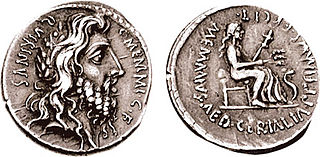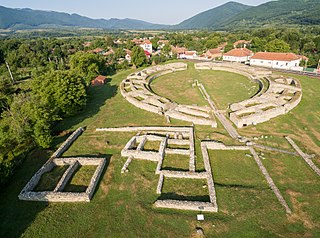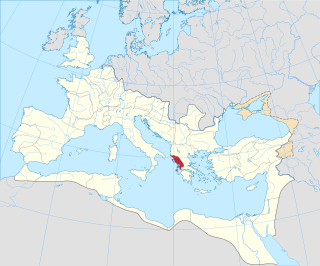
The Quirinal Hill is one of the Seven Hills of Rome, at the north-east of the city center. It is the location of the official residence of the Italian head of state, who resides in the Quirinal Palace; by metonymy "the Quirinal" has come to stand for the Italian president. The Quirinal Palace has an extension of 1.2 million sq ft (110,000 m2).

Jupiter, also known as Jove, is the god of the sky and thunder, and king of the gods in ancient Roman religion and mythology. Jupiter was the chief deity of Roman state religion throughout the Republican and Imperial eras, until Christianity became the dominant religion of the Empire. In Roman mythology, he negotiates with Numa Pompilius, the second king of Rome, to establish principles of Roman religion such as offering, or sacrifice.

In ancient Roman religion and mythology, Liber, also known as Liber Pater, was a god of viticulture and wine, male fertility and freedom. He was a patron deity of Rome's plebeians and was part of their Aventine Triad. His festival of Liberalia became associated with free speech and the rights attached to coming of age. His cult and functions were increasingly associated with Romanised forms of the Greek Dionysus/Bacchus, whose mythology he came to share.

In Roman mythology and religion, Quirinus is an early god of the Roman state. In Augustan Rome, Quirinus was also an epithet of Janus, as Janus Quirinus.

Spes was worshipped as a goddess in ancient Roman religion. Numerous temples to Spes are known, and inscriptions indicate that she received private devotion as well as state cult.

The Roman Forum, also known by its Latin name Forum Romanum, is a rectangular forum (plaza) surrounded by the ruins of several important ancient government buildings at the centre of the city of Rome. Citizens of the ancient city referred to this space, originally a marketplace, as the Forum Magnum, or simply the Forum.

The Capitolium or Capitoline Hill, between the Forum and the Campus Martius, is one of the Seven Hills of Rome.

Lanuvium, modern Lanuvio, is an ancient city of Latium vetus, some 32 kilometres (20 mi) southeast of Rome, a little southwest of the Via Appia.

Juno was an ancient Roman goddess, the protector and special counsellor of the state. She was equated to Hera, queen of the gods in Greek mythology and a goddess of love and marriage. A daughter of Saturn and Ops, she was the sister and wife of Jupiter and the mother of Mars, Vulcan, Bellona, Lucina and Juventas. Like Hera, her sacred animal was the peacock. Her Etruscan counterpart was Uni, and she was said to also watch over the women of Rome. As the patron goddess of Rome and the Roman Empire, Juno was called Regina ("Queen") and was a member of the Capitoline Triad, centered on the Capitoline Hill in Rome, and also including Jupiter, and Minerva, goddess of wisdom.

Ancient Roman temples were among the most important buildings in Roman culture, and some of the richest buildings in Roman architecture, though only a few survive in any sort of complete state. Today they remain "the most obvious symbol of Roman architecture". Their construction and maintenance was a major part of ancient Roman religion, and all towns of any importance had at least one main temple, as well as smaller shrines. The main room (cella) housed the cult image of the deity to whom the temple was dedicated, and often a table for supplementary offerings or libations and a small altar for incense. Behind the cella was a room, or rooms, used by temple attendants for storage of equipment and offerings. The ordinary worshiper rarely entered the cella, and most public ceremonies were performed outside of the cella where the sacrificial altar was located, on the portico, with a crowd gathered in the temple precinct.
The Capitoline Triad was a group of three deities who were worshipped in ancient Roman religion in an elaborate temple on Rome's Capitoline Hill. It comprised Jupiter, Juno and Minerva. The triad held a central place in the public religion of Rome.

A Capitolium (Latin) was an ancient Roman temple dedicated to the Capitoline Triad of gods Jupiter, Juno and Minerva. A capitolium was built on a prominent area in many cities in Italy and the Roman provinces, particularly during the Augustan and Julio-Claudian periods. Most had a triple cella, one for each god.

Latium is the region of central western Italy in which the city of Rome was founded and grew to be the capital city of the Roman Empire.

The main road to the Roman Capitol, the Clivus Capitolinus starts at the head of the Roman Forum beside the Arch of Tiberius as a continuation of the Via Sacra; proceeding around the Temple of Saturn and turning to the south in front of the Portico Dii Consentes, it then climbs up the slope of the Capitoline Hill to the Temple of Jupiter Optimus Maximus at its summit. This was traditionally the last and culminating portion of all Roman triumphs.

Ulpia Traiana Augusta Dacica Sarmizegetusa was the capital, the first, and largest city of Roman Dacia, named after Sarmizegetusa the former Dacian capital, located some 30 km away. It was founded in 106 as a colonia deducta and elevated to metropolis during the reign of Severus Alexander. The present village of Sarmizegetusa has been built over parts of it.

The Latins, sometimes known as the Latials or Latians, were an Italic tribe that included the early inhabitants of the city of Rome. From about 1000 BC, the Latins inhabited the small region known to the Romans as Old Latium, the area in the Italian Peninsula between the river Tiber and the promontory of Mount Circeo 100 km (62 mi) southeast of Rome. Following the Roman expansion, the Latins spread into the Latium adiectum, inhabited by Osco-Umbrian peoples.
The Aventine Triad is a modern term for the joint cult of the Roman deities Ceres, Liber and Libera. The cult was established c. 493 BC within a sacred district (templum) on or near the Aventine Hill, traditionally associated with the Roman plebs. Later accounts describe the temple building and rites as "Greek" in style. Some modern historians describe the Aventine Triad as a plebeian parallel and self-conscious antithesis to the Archaic Triad of Jupiter, Mars and Quirinus and the later Capitoline Triad of Jupiter, Minerva and Juno. The Aventine Triad, temple and associated ludi served as a focus of plebeian identity, sometimes in opposition to Rome's original ruling elite, the patricians.

The Temple of Quirinus was an ancient Roman temple built on the western half of the Quirinal Hill near the Capitolium Vetus, on a site which now equates to the junction between Via del Quirinale and Via delle Quattro Fontane, beside Piazza Barberini. Domitian later built the Temple of the gens Flavia nearby.

The province of Epirus was a province of the Roman Empire, covering the region of Ancient Epirus. Rome first annexed the region in 167 BC, in the aftermath of the Third Macedonian War, and initially put the region in the larger Roman province of Macedonia, which at the time covered the whole of the Hellenistic world in mainland Europe. In 27 BC, Epirus and Achaea were separated from Macedonia and grouped into the senatorial province of Achaea, with the exception of its northernmost part, which remained part of the province of Macedonia. Under Emperor Trajan, sometime between 103 and 114 AD, Epirus became a separate province, under a procurator Augusti. The new province extended from the Gulf of Aulon (Vlorë) and the Acroceraunian Mountains in the north to the lower course of the Acheloos River in the south, and included the northern Ionian Islands of Corfu, Lefkada, Ithaca, Cephallonia, and Zakynthos.

The Regio VI Alta Semita is the sixth regio of imperial Rome, under Augustus's administrative reform. Regio VI took its name from the street passing over the Quirinal Hill. It was a large regio that also encompassed the Viminal Hill, the lower slopes of the Pincian, and the valleys in-between.



















